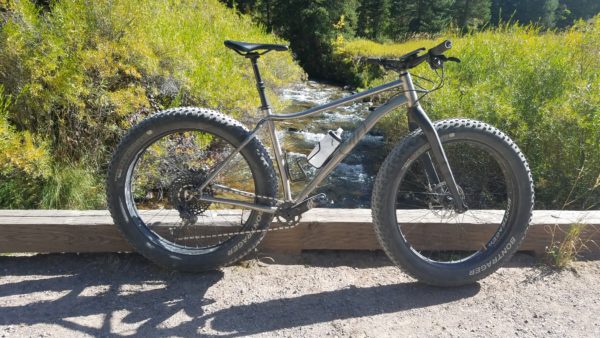
You may ask yourself who is Why? Why Cycles is a fairly new company, being about 2 years old. Their focus is making high-performance, titanium bicycles, with their newest release being the Big Iron fat bike. Why may be fairly new, but the company is made up a number of individuals that have extensive knowledge in the bike world, including owner Adam Miller, who co-founded Borealis. Adam has been a major player in the fat bike world, he designed the first carbon fat bike with Borealis. Why also works with six-time ITI winner Pete Basinger on the design, product development and testing of the Big Iron.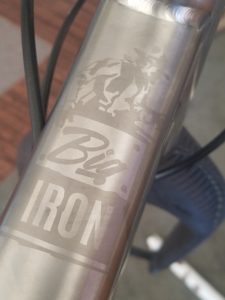
We were stoked, when we found out that we would be testing the Why Big Iron, for fat-bike.com. We were shipped two test bikes in mid-July. Becky received a size medium and Bryon an XL. The specific components of each bike can be found in our Product Spotlight.
Since receiving the bikes in July, we have each covered over 1200 miles of gravel, pavement, dirt, single-track, and even a little sand. We took these trusty titanium steeds 900 miles on a three-week bike packing excursion through Alaska. We have enjoyed ripping single-track and crushing gravel throughout Teton Valley. (spoiler alert!) We have been blown away by these bikes!
The Bike
 This beautiful ti frame is designed to run 27.5″ wheels with up to a 4.5″ tire and 26″ wheels with a 5″ tire, or 29″ wheel with 3″ tires. We tested a variety of tire sizes. Bryon rode with 27.5″ a Jackalope wheelset, and 4.5″ Bontrager Barbegazi tires. Becky first rode with a set of 3.8″ Maxxis Minions on 27.5″ Mulefut wheels. Then she swapped for 26″ wheels with a set of 45Nrth Dillinger 4.8″ tires. We found that the Big Iron rode really well no matter what wheel set we were rolling. We did find that the fastest rolling set was the big 27.5″ wheelset with the fat 4.5″ Barbegazi tires.
This beautiful ti frame is designed to run 27.5″ wheels with up to a 4.5″ tire and 26″ wheels with a 5″ tire, or 29″ wheel with 3″ tires. We tested a variety of tire sizes. Bryon rode with 27.5″ a Jackalope wheelset, and 4.5″ Bontrager Barbegazi tires. Becky first rode with a set of 3.8″ Maxxis Minions on 27.5″ Mulefut wheels. Then she swapped for 26″ wheels with a set of 45Nrth Dillinger 4.8″ tires. We found that the Big Iron rode really well no matter what wheel set we were rolling. We did find that the fastest rolling set was the big 27.5″ wheelset with the fat 4.5″ Barbegazi tires.
A few things, in particular, stood out with this bike! First off, all Why Cycles bikes come set up tubeless. This is a great touch and a big time saver for the end user.
Next, the front brakes came with 180mm front rotors, this is a great upgrade. We found this most noticeable and beneficial to us, when we were riding the bikes fully loaded and descending.
The main triangle of the Big Iron features a shaped down-tube to keep lateral flex at bay.
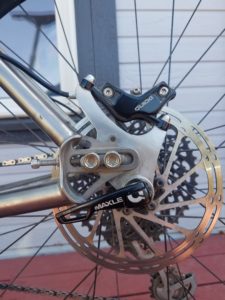 The bikes have adjustable dropouts which gives you a ton of set up choices. The short rear end is great for trail ripping or even a quick trip through the local pump track, while when the rear end is long and stretched the bike is stable for riding through soft deep snow, or sand and on long washboarded gravel roads. We ran the drop outs about centered and they seemed to work really well for everything we put each bike through thus far.
The bikes have adjustable dropouts which gives you a ton of set up choices. The short rear end is great for trail ripping or even a quick trip through the local pump track, while when the rear end is long and stretched the bike is stable for riding through soft deep snow, or sand and on long washboarded gravel roads. We ran the drop outs about centered and they seemed to work really well for everything we put each bike through thus far.
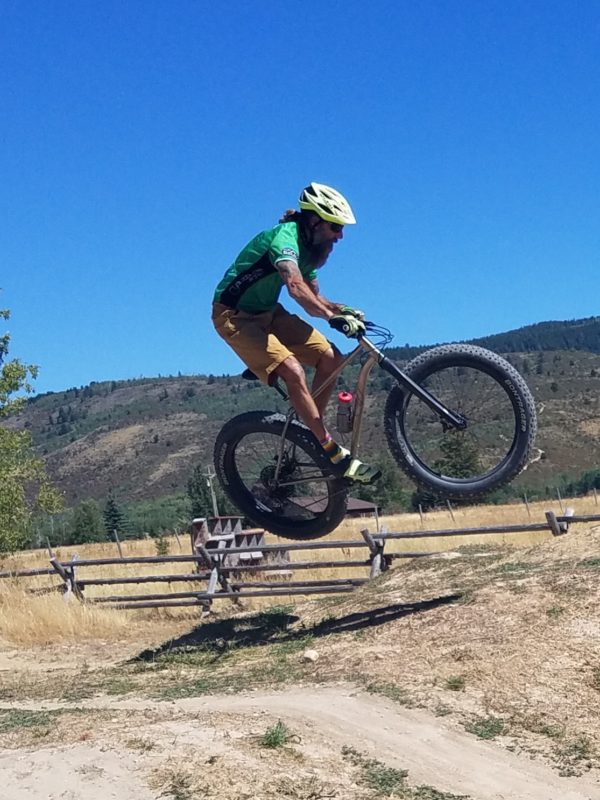
The Ride and Handling:
When the bikes arrived our main goal was to get them ready for 3 weeks of touring through Alaska so our amount of time to ride was limited. We have to admit the thought of riding a bike all day almost everyday for three weeks without having spent a considerable amount of time on it made us a little nervous. We have
spent a lot of time to set up our personal rigs for the big miles and long hours. After the first couple short rides on the Big Irons, we were definitely beginning to feel much better about our decision to test these bikes, on such a big trip. Our first two rides on the bikes were a gravel ride around Teton Valley and some local single track the following day. At this point, we were trying to decide if the bikes were as amazing as we thought, or was it the new bike psyche, 900 miles in Alaska would positively sort that out!
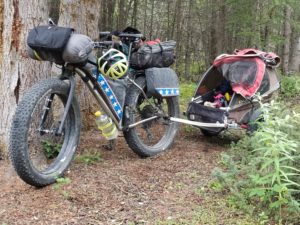
 After a few days of working on our set ups, we finally had both bikes outfitted with bags, racks, cages, cradles and everything else we thought we may need. Our first time riding the bikes fully-loaded and weighted down was when we left our hotel in Anchorage. To say we were heavily packed and loaded was an understatement, but all of our gear was necessary. The first several days of the trip were on asphalt, so with the tires inflated nice and firm, the bikes were smooth, solid, and fast.
After a few days of working on our set ups, we finally had both bikes outfitted with bags, racks, cages, cradles and everything else we thought we may need. Our first time riding the bikes fully-loaded and weighted down was when we left our hotel in Anchorage. To say we were heavily packed and loaded was an understatement, but all of our gear was necessary. The first several days of the trip were on asphalt, so with the tires inflated nice and firm, the bikes were smooth, solid, and fast.
We could definitely feel a little flex in the titanium frames with so much weight on the bikes, compared to our personal rides at home; one is carbon and one is aluminum. That little bit of flex was really nice when we got to the rougher dirt and gravel roads, as it provided a noticeable dampening in vibrations. The beauty of titanium is not only does it provide vibration dampening, but at the same time still transfers all of your power from the pedals to the rear wheel.

We both loved the Ergon saddles that came stock on the bikes. They were immediately comfortable and it was no problem to peddle on them all day!

We also liked the SRAM GX Eagle drive trains with their wide range of gearing for any terrain.
Our trip had a lot of rain. The bikes were ridden day after day in the silt, sand, and mud without any creaking or noises developing along the way. The internal cable routing was silent. There were no rattles or vibrations, to be heard or felt. The Big Irons were a pleasure to get on day after day. There was never a morning where either one of us was not excited to throw a leg over the bikes and ride.

Where the Why Big Iron really shined was when we got back home and were able to get out on some single-track missions. The bikes climbing ability is incredible, The bikes felt light and powerful paired with the big wheels…They rolled over just about anything in their path. The harder and faster you pushed the Big Iron, the better it got.
The Big Irons cornering ability is spot on. The bike easily goes wherever you point it. Something we never noticed with the Big Iron was any type of auto steering, weighted or unweighted, regardless of the tires that we ran. The Bontrager Haru Pro Carbon Fork was a great compliment to the Big Iron. The fork was stiff and solid, where it needed to be, but had just the right amount of flex and vibration dampening to give you a smooth and controlled ride. On the touring side of things, the fork lacked having any cargo mounts. This is a problem that can be solved if you don’t mind using some basic hose clamps or an alternate mounting system.
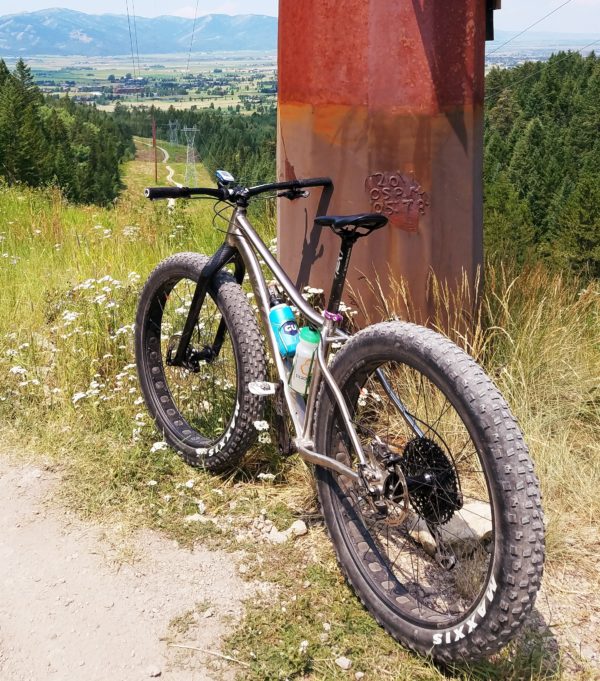
The Big Iron is suspension corrected, so you could put on a suspension fork and definitely take this machine to a next level trail riding experience.
Overall Thoughts
Plain and simple, the Big Iron rides like a mountain bike with fat tires! We have thoroughly enjoyed our experience while testing, touring and riding these bikes. The only thing that could of made our experience any better would of been the chance to ride these beauties in the snow.
We award the Big Iron 4.75 out of 5 purple fireballs and highly recommend giving Why Cycles and the Big Iron a closer look!


No comments yet.